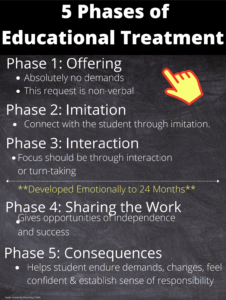Five Phases of Educational Treatment
Interacting with the Learner
It is imperative that all individuals with multiple special needs be given the opportunity to participate in educational programming that meets the learner’s developmental needs. In her book Are You Blind? Dr. Nielsen describes how some children with multiple special needs exhibit severe anxiety or behavioral challenges including autistic-like, stereotypical, aggressive, self-stimulatory, and self-injurious behaviors. Understanding why these behaviors occur is key to appropriate interactions with special needs children.
In providing activities for those with special needs, the five phases of educational treatment identify the adult’s role in recognizing the emotional level of a learner and the key factors in building a trusting relationship between educator and student, parent/caregiver and child. Only after trust has been established, can an adult be an effective role model and educator for those individuals with multiple special needs. According to Lev Vygotsky, a Russian psychologist, there exists a “zone of proximal development” which refers to “the range of abilities that an individual can perform with assistance but cannot yet perform independently. These skills are called ‘proximal’ because the individual is close to mastering them but needs more guidance and practice in order to perform these actions independently.” (The Zone of Proximal Development as Defined by Vygotsky, Kendra Cherry)
What is the emotional level of a learner and why is it so important?
Dr. Nielsen describes the emotional level as the method by which a child makes contact with an adult. At an early age, this contact is non-verbal and frequently based on visual and physical cues. Types of contact change in the typically developing child as he/she establishes self-identity, improves verbal communication skills, and demonstrates independence. Children with significant disabilities need to develop a healthy self-identity and connections with others, just like their peers. Because of their sensory impairment(s) and/or physical impairments, children with significant disabilities experience high levels of stress. Current brain research indicates that early stress can negatively impact brain development, but positive interactions with caring adults can build resilience in children to overcome the stress they meet with in life. To learn more about this, visit the Center on the Developing Child at Harvard University website.
Any person should develop the ability to:
- Identify and understand his/her own feelings;
- Accurately read and comprehend emotional states in others;
- Manage strong emotions and their expressions in a constructive manner;
- Regulate his/her own behavior;
- Develop empathy for others; and
- Establish and maintain relationships.

The emotional level of a child with multiple disabilities can be more difficult to identify. Emotional and social development is often overlooked as part of needed instruction for children with multiple disabilities.
It is important that the adult understanding how visual, cognitive, sensory or physical impairments effect the development of the emotional level and understand the adult’s own reactions toward a child with multiple disabilities. Does the adult emphasize activity and independence or promote passivity and dependence?
The Five Phases of Educational Treatment provide teachers, professionals, and parents with the techniques necessary to treat the emotional and social level of a learner, as well as academic, cognitive or physical ability level.
Some Additional Resources
Are You Blind? by Lilli Nielsen available in the USA through Lilliworks.
Download the article, Five Phases of Educational Treatment Used in Active Learning written by Kate Moss (Hurst), Education Specialist, Texas Deafblind Outreach.
Learn more about interaction with children who are deafblind or blind with additional disabilities on the Texas Deafblind Project website.
Understanding and remembering the Five Phases of Educational Treatment is important when working with a child. You may want to download this poster created by Shay Utley, COMS, from Mansfield ISD to post in your room. Active Learning posters by Shay Utley, COMS


